Students can practice TS Class 10 Maths Solutions Chapter 8 Similar Triangles Ex 8.4 to get the best methods of solving problems.
TS 10th Class Maths Solutions Chapter 8 Similar Triangles Exercise 8.4
Question 1.
Prove that the sum of the squares of the sides of a rhombus is equal to the sum of the squares of its diagonals. (AS2)
Solution:
ABCD is a rhombus. Let its diagonals AC and BD meet at ‘O’.
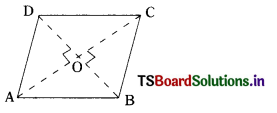
In ∆AOD, ∠AOD = 90°
∴ By Pythagoras theorem,
AD2 = OA2 + OD2 …………… (1)
In ∆COD, ∠COD = 90°
∴ CD2 = OC2 + OD2 …………… (2)
In ∆ AOB, ∠AOB = 90°
∴ AB2 = OA2 + OB2 ……………… (3)
In ∆BOC, ∠BOC = 90°
∴ BC2 = OB2 + OC2 ……………… (4)
Adding (1), (2), (3) & (4), we get
AD2 + CD2 + AB2 + BC2 = OA2 + OD2 + OC2 + OD2 + OA2 + OB2 + OB2 + OC2
= OA2 + OA2 + OC2 + OC2 + OB2 + OB2 + OD2 + OD2
= OA2 + OA2 + OA2 + OA2 + OB2 + OB2 + OB2 + OB2 (∵ OC = OA & OD = OB)
= 4OA2 + 4OB2
= (2OA2 + 2OB2) (∵ 2OA = AC & 2OB = BD)
![]()
Question 2.
ABC is a right triangle right angled at B. Let D and E be any points on AB and BC respectively.
Prove that AE2 + CD2 = AC2 + DE2. (AS2)

Solution:
In ∆ABE, ∠B = 90°
By Pythagoras Theorem,
AE2 = AB2 + BE2 …………… (1)
In ∆CBD, ∠CBD = 90°
By Pythagoras Theorem,
CD2 = BD2 + BC2 ……………. (2)
Adding (1) & (2), we get AE2 + CD2 = AB2 + BE2 + BD2 + BC2
= (AB2 + BC2) + (BE2 + BD2)
= AC2 + DE2 (∵ In ∆ABC, ∠B = 90°)
(∴ AB2 + BC2 = AC2 and In ∆DBE, ∠B = 90° ∴ BD2 + BE2 = DE2)
Question 3.
Prove that three times the square of any side of an equilateral triangle is equal to four times the square of the altitude. (AS2)
Solution:
ABC is an equilateral triangle,
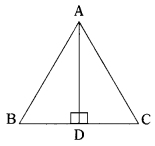
(∵ AD ⊥ BC)
(i.e„) AB = BC = CA, AD ⊥ BC
In ∆les ADB and ADC
∠ADB = ∠ADC = 90°
Hyp. AB = Hyp. AC
AD is common.
∴ ∆ ADB = ∆ADC
∴ BD = DC
In ∆ADB, ∠ADB = 90°
By Pythagoras Theorem,
AB2 = AD2 + BD2
= AD2 + \(\left(\frac{\mathrm{BC}}{2}\right)^2\) (∵ BD = CD)
= AD2 + \(\frac{\mathrm{BC}^2}{4}\) = \(\frac{4 \mathrm{AD}^2+\mathrm{BC}^2}{4}\)
= \(\frac{4 \mathrm{AD}^2+\mathrm{AB}^2}{4}\) (∵ BC = AB)
⇒ 4AB2 = 4AD2 + AB2
⇒ 4AB2 – AB2 = 4AD2
⇒ 3AB2 = 4AD2
![]()
Question 4.
PQR is a triangle right angled at P and M is a point on QR such that PM ⊥QR. Show that PM2 = QM . MR (AS2)
Solution:
∆PRM and ∆PQM are right angled triangles.
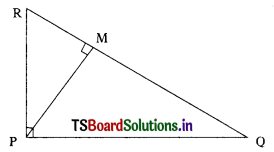
∴ PR2 = PM2 + RM2 ……………. (1)
and PQ2 = PM2 + QM2 …………… (2)
Adding (1) & (2), we get
PR2 + PQ2 = PM2 + RM2 + PM2 + QM2
⇒ QR2 = 2PM2 + RM2 + QM2
(∵ In ∆PQR, ∠P = 90° ∴ QR2 = PR2 + PQ2)
⇒ (QM + MR)2 = 2PM2 + RM2 + QM2
⇒ QM2 + RM2 + 2QM. MR = 2PM2 + RM2 + QM2
⇒ 2QM. MR = 2PM2
⇒ PM2 = QM. MR
Question 5.
ABD is a triangle right angled at A and AC ⊥ BD. Show that (AS2)
(i) AB2 = BC. BD
(ii) AC2 = BC . DC
(iii) AD2 = BD . CD

Solution:
(i) In ∆les BAD and BCA,
∠BAD = ∠BCA = 90°
∠B is common.
∴ ∆BAD ~ ∆BCA

Hence, their corresponding sides are in proportion.
⇒ \(\frac{\mathrm{BD}}{\mathrm{AB}}\) = \(\frac{\mathrm{AB}}{\mathrm{BC}}\)
⇒ AB2 = BC . BD ……………. (1)
(ii) In ∆les ACB and DCA,
∠ACB = ∠DCA = 90°
∠A is common.
∴ ∆ ACB ~ ∆DCA

Hence, their corresponding sides are in pro-portion.
⇒ \(\frac{\mathrm{AC}}{\mathrm{DC}}\) = \(\frac{\mathrm{BC}}{\mathrm{AC}}\)
⇒ AC2 = BC . DC ……………. (2)
![]()
iii) In ∆les DAB and DCA,
∠DAB = ∠DCA = 90°
∠D is common.
∴ ∆DAB ~ ∆DCA
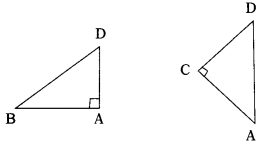
Hence, their corresponding sides are in proportion.
⇒ \(\frac{\mathrm{BD}}{\mathrm{AD}}\) = \(\frac{\mathrm{AD}}{\mathrm{CD}}\)
⇒ AD2 = BD . CD ……………. (3)
Question 6.
ABC is an isosceles triangle right angled at C. Prove that AB2 = 2AC2. (AS2)
Solution:
In ∆ABC, ∠ACB = 90°

∴ AB is the hypotenuse, since it is an isosceles triangle, AC = BC
By Pythagoras Theorem,
AB2 = AC2 + BC2
= AC2 + (AC)2 (∵ BC = AC)
= AC2 + AC2 = 2AC2
Question 7.
‘O’ is any point in the interior of a triangle ABC. OD ⊥ BC, OE ⊥ AC and OF ⊥ AB. Show that
i) OA2 + OB2 + OC2 – OD2 – OE2 – OF2 = AF2 + BD2 + CE2
ii) AF2 + BD2 + CE2 = AE2 + CD2 + BF2. (AS2)
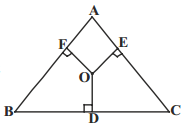
Solution:
In ∆ABC, OD, OE and OF are drawn perpendicular to BC, CA and AB respectively. Join OB, OC and OA.
i) In ∆AFO, ∠AFO = 90°
∴ By Pythagoras Theorem,
OA2 = AF2 + OF2 …………….. (1)
In ABDO, ∠BDO = 90°
∴ OB2 = OD2 + BD2 ………………. (2)
In ACEO, ∠CEO = 90°
∴ OC2 = OE2 + CE2 ……………….. (3)
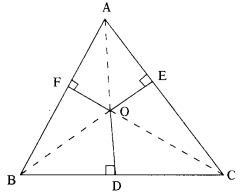
Adding (1), (2) & (3), we get
OA2 + OB2 + OC2 = AF2 + OF2 + OD2 + BD2 + OE2 + CE2
⇒ OA2 + OB2 + OC2 – OD2 – OE2 – OF2
= AF2 + BD2 + CE2 …………….. (4)
ii) From (4), we get
AF2 + BD2 + CE2 = (OA2 – OE2) + (OB2 – OF2) + (OC2 – OD2)
= AE2 + BF2 + CD2 (∵ In the right triangle AEO,
∠AEO = 90° ∴ OA2 = OE2 + AE2
⇒ OA2 – OE2 = AE2
Similarly, in the right triangle OFB,
∠OFB = 90°; ∴ OB2 = OF2 + BF2
⇒ OB2 – OF2 = BF2
Lastly, in the right triangle ODC,
∠ODC = 90°,
OC2 = OD2 + CD2
⇒ O2 – OD2 = CD2
![]()
Question 8.
A wire attached to a vertical pole of height 18m is 24m long and has a stake attached to the other end. How far from the base of the pole should the stake be driven so that the wire will be taut ? (AS4)
Solution:
In triangle ABC, ∠B = 90°
AB stands for the vertical pole AC represents the wire ‘B’ denotes ‘base’ and C denotes ‘stake’.
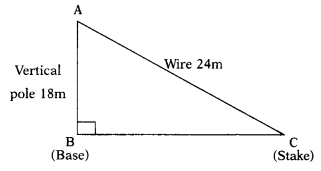
By Pythagoras Theorem,
AC2 = AB2 + BC2
⇒ BC2 = AC2 – AB2
= (24)2 – (18)2
= 576 – 324 = 252
∴ BC = \(\sqrt{252}\)
= \(\sqrt{252}\) = \(\sqrt{2 2 3 3 7}\)
= \(\sqrt{2^2 \times 3^2}\) × 7
= 2 × 3 × \(\sqrt{7}\) = 6\(\sqrt{7}\) Therefore, the stake should be driven 6 \(\sqrt{7}\) meters for the base of the pole so that the wire will be taut.
Question 9.
Two poles of heights 6 m and 11 m stand on a plane ground. If the distance be¬tween the feet of the poles is 12m find the distance between their tops. (AS4)
Solution:
AB and CD represent two poles of heights 11m and 6m respectively. BC represents the distance between their feet. BC = 12m
Draw DE || CB intersecting AB at E. Join AD.

ED = BC = 12m.
EB = DC = 6m
AE = AB – CD = 11 – 6 = 5m
In ∆AED, ∠AED = 90°
∴ By Pythagoras theorem,
AD2 = AE2 + DE2
= 52 + 122 = 25 + 144 = 169
∴ AD = \(\sqrt{169}\) = 13m
∴ The distance between the tops of the poles = 13 meters.
![]()
Question 10.
In an equilateral triangle ABC, D is a point on side BC such that BD = \(\frac{1}{3}\) BC. Prove that 9AD2 = 7 AB2. (AS2)
Solution:
ABC is an equilateral triangle.
∴ AB = BC = CA
D is a point on BC, such that
BD = \(\frac{1}{3}\) BC; Draw AE ⊥ BC.

∴ E bisects BC.
⇒ BE = CE
In ∆ABD, ∠ADB is obtuse.
∴ AB2 = AD2 + BD2 + 2 BD . DE
⇒ AD2 = AB2 – BD2 – 2BD. DE
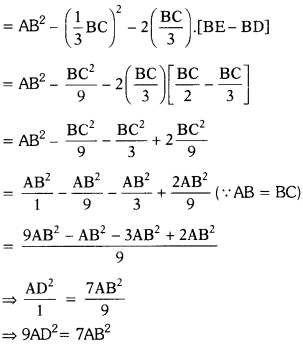
![]()
Question 11.
In the given figure, ABC Is a triangle right angled at B. D and E are points on BC trisect it. Prove that 8AE2 = 3AC2 + 5AD2. (AS2)
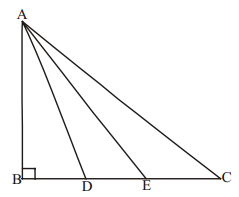
Solution:
In ∆ADC, ∠ADC is obtuse.
∠B = 90° and BD = DE = EC.
Let BD = DE = EC = x
AC2 = AD2 + DC2 + 2 DC. DB
= AD2 + (2x)2 + 2. 2x. x
= AD2 + 4x2 + 4x2
= AD2 + 8x2 ………………… (1)
In ∆ABD, ∠B = 90°
∴ AD2 = AB2 + BD2 (By Pythagoras Theorem)
⇒ AB2 = AD2 – BD2 = AD2 – x2 …………. (2)
In ∆ABE = ∠B = 90°
∴ AE2 = AB2 + BE2 = AB2 + (2x)2 = AB2 + 4x2
∴ AB2 = AE2 – 4x2 ……………. (3)
From (2) & (3), we get
AE2 – 4x2 = AD2 – x2
AE2 – 4x2 = AD2 – x2 + 4x2 = AD2 + 3x2
8AE2 = 8(AD2 + 3x2)
= 8AD2 + 24x2 ………………. (4)
From (1),
3AC2 + 5 AD2
= 3 (AD2 + 8x2) + 5 AD2
= 3 AD2 + 24x2 + 5AD2
= 8AD2 + 24x2 ……………….. (5)
From (4) & (5), we have,
8AE2 = 3AC2 + 5 AD2
![]()
Question 12.
ABC is an isosceles triangle right angled at B. Similar triangles ACD and ABE are constructed on sides AC and AB. Find the ratio between the areas of ∆ABE and ∆ACD.

Solution:
In ∆ABC, ∠B = 90°
Let AB = BC = x

∴ By Pythagoras theorem,
AC2 = AB2 + BC2 = x2 + x2 = 2x2
∴ AC = \(\sqrt{2 \mathrm{x}^2}\) = \(\sqrt{2}\)x
By problem ∆ACD ~ ∆ABE,
Therefore, \(\frac{\text { area of }(\triangle \mathrm{ABE})}{\text { area of }(\triangle \mathrm{ACD})}\) = \(\frac{\mathrm{AB}^2}{\mathrm{AC}^2}\)
= \(\frac{(x)^2}{(\sqrt{2} x)^2}\) (∵ AB = x and AC = \(\sqrt{2}\)x )
= \(\frac{x^2}{2 x^2}\) = \(\frac{1}{2}\)
Hence, the ratio between the areas of ∆ABE and ∆ACD = 1 : 2